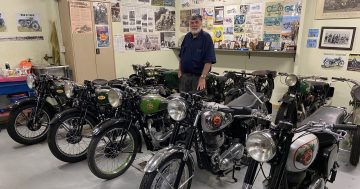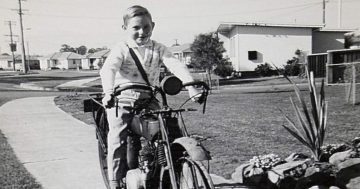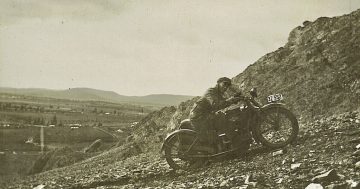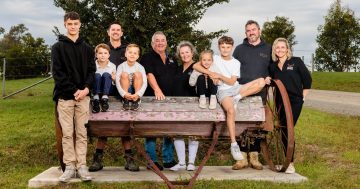
Tony ‘Skid’ Marks with his painting of Australian Motorcycle Grand Prix winner Dave Brewster on his Indian machine. Photo: John Thistleton.
In his early high school years in the 1970s Tony ‘Skid’ Marks watched in awe as life-long motorbike enthusiast Doug Burrows applied his skills as a signwriter with a brush to his Formula 500 car (with motorbike engine).
“That’s it,” Skid said emphatically, admiring the brushwork. “That’s what I want to do.” That moment shaped the rest of his life as a signwriter, artist, musician and motorbike fanatic.
As the sign writing craft gives way to technology and cut out vinyl, Skid has stuck to his first love of sign writing, specialising in gold leaf lettering and often finds a way to combine this with his passion for motorbikes.
“Sign writing is an interesting trade,” he said. “It has a very diversified skillset. You need to be a welder, you need to be a carpenter, you need to make your own canvasses, paint up your own boards, competently and safely get up a ladder and fix panels to a shop so they don’t fall down and kill anybody.”
One of his latest works, an evocative portrait of early racing legend Dave Brewster revives the spirit of Australia’s first Motorcycle Grand Prix in Goulburn 100 years ago. Brewster was riding an Indian in the historic event, and the motorbike manufacturer is right behind the anniversary celebration planned for 21-23 June.
Goulburn Chamber of Commerce commissioned the painting, and Indian Australia has snapped it up. Skid is planning two more paintings from that 208-mile race, including a wide, panoramic scene of a bunch of bikes and their hardy riders taken from a poor-quality photo from a freezing cold day under leaden skies in June, 1924, when everyone was rugged up in wool and leather.
Before he had completed his high school education, Skid was enrolled in a signwriting course at Goulburn TAFE College two nights a week, in addition to his classes at school. At TAFE he was learning his future trade from teachers Iris Light and prolific signwriter Tommy Kofod. He came through his time with other notable signwriters including John Cottle, Russell Mitchell, Gavin Travis, Warren Brown and Mick Adams.
He worked at Knowlman’s Department Store and for a time continued his apprenticeship with Jeff Baldock from Hobbit Signs.
“We struggled to make wages most weeks,” Skid said. “At the end of 1981 I had an opportunity to go touring with a band and knew Jeff was struggling to pay me my $84 a week, so I left.”
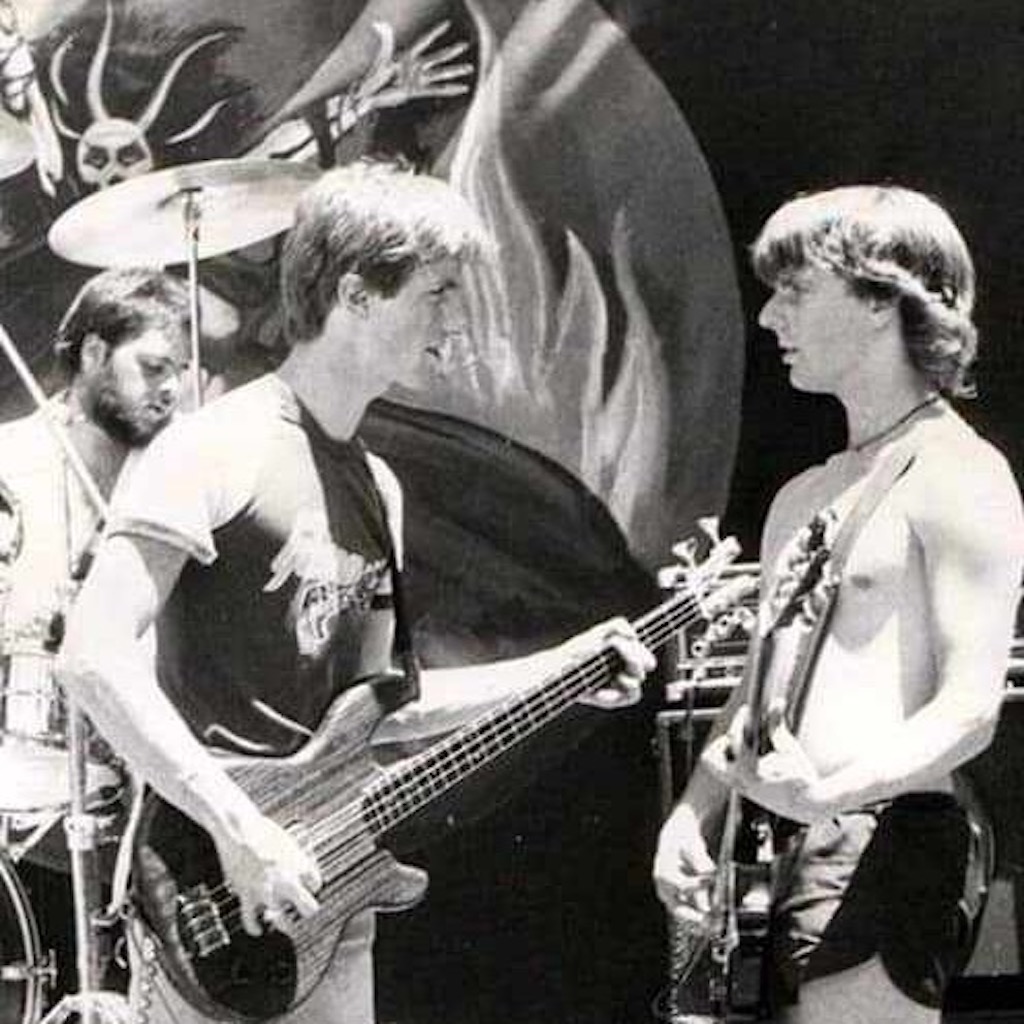
Skid Marks, right, playing with Sledge. Photo: Skid Marks collection.
He lined up with the Goulburn band ‘Sledge’. “Geoff Brown, Chris Pine, now one of the world’s best live sound engineers now living and working in England, Eric Haywood, sadly he has passed away, and Ian Russell,” Skid said. “Ian was our lead vocalist and an English teacher at Goulburn High School in the early 80s, so we plucked him out of teaching and went touring around. [We] made mistakes, did dumb things and had a great time.”
He has since returned to his trade, left it briefly to dabble in the production side of the Goulburn Post, had several cartoons published, and helped produce about 12 or more editions of Classic Motorcycling published by musician and fellow motorbike fanatic Steve Hazelton.
These days he does painting commissions and sign writing. People approach him to paint their horses and dogs, but the work he most loves is painting motorbikes and applying his sign writing to hot rod cars.
“I have been living in the hot rod world for 20 years,” he said. “They love their pin striping, their hand-lettered stuff on their old trucks. I’ve carved out a niche in that world, custom paint work,” he said.
“I go to car shows and work on-site doing a cross between street theatre and folk art, a comedy act. It’s a lot of fun and people like to hang around and ask a thousand questions and pay me to put stripes on their car. It’s like going and getting a tattoo; it’s a great way of earning a living.”
Two jobs he is most proud of are in the heart of Australia’s most significant war memorials. One was restoring the gold lettering on a large marble plinth outside the Australian War Memorial which he proudly points out to friends each Anzac Day.

Bowning Public School engaged Skid to paint this mural marking 175 years of education. Photo: Skid Marks.
On Anzac Parade, he and a colleague fabricated in steel letters, ‘Vietnam’, on the Australian Vietnam Forces National Memorial. Welding, grounding and shaping the letters and powder coating them, he chimed in with a team of others to complete the works. He was also involved in another section of substantial lettering on the memorial that had to be fixed to concrete.
He is happy these signs will outlive him, long after vinyl signs now in vogue everywhere fade and deteriorate.







